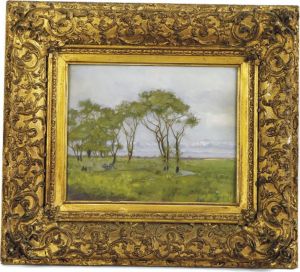George E. Cook Paintings
George Esten Cooke was an American artist who specialized in portrait and landscape painting. Born on September 5, 1819, in St. Mary's County, Maryland, he grew up in a period when the United States was undergoing significant growth and change. Cooke showed an early interest in the arts and pursued his passion despite the lack of formal art education available in his region at the time.
Cooke's career began in earnest during the 1830s after he moved to Washington, D.C., where he found work as a portrait painter. Here, he painted the portraits of some prominent figures of the day, which helped him to establish a reputation as a skilled artist. His work was characterized by a keen attention to detail and a strong grasp of his subjects' personalities, which he captured with sensitivity and depth.
In 1846, Cooke traveled to Europe, as was common for American artists of the time who desired to refine their skills and study the Old Masters. He spent a significant amount of time in Italy, particularly in Florence and Rome, where he was deeply influenced by the works of Renaissance artists. This European sojourn allowed him to develop his technique and exposed him to a broader range of artistic styles and methods.
Upon returning to the United States, Cooke continued to work as a portraitist but also turned his attention more fully to landscape painting. He traveled extensively throughout the Eastern United States, capturing the beauty of the American countryside. His landscapes are noted for their detailed realism and romantic sensibility, often imbued with a sense of the sublime that was a hallmark of the Hudson River School, although Cooke is not typically classified strictly as a member of this group.
Throughout his career, Cooke faced numerous financial difficulties, which led him to move frequently and seek patrons across the country. Despite these challenges, he continued to produce a significant body of work. He passed away on October 27, 1902, in Nashville, Tennessee. Cooke's paintings are now held by various institutions and continue to be appreciated for their contribution to the artistic heritage of the United States during the 19th century.
